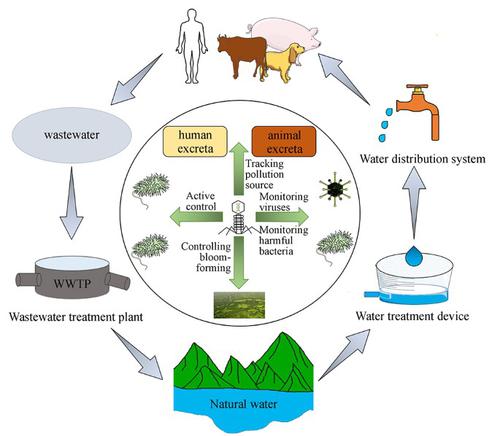Frontiers of Environmental Science & Engineering ( IF 6.4 ) Pub Date : 2020-12-05 , DOI: 10.1007/s11783-020-1378-y Mengzhi Ji 1 , Zichen Liu 1 , Kaili Sun 1 , Zhongfang Li 2 , Xiangyu Fan 1 , Qiang Li 1

|
Wastewater is a breeding ground for many pathogens, which may pose a threat to human health through various water transmission pathways. Therefore, a simple and effective method is urgently required to monitor and treat wastewater. As bacterial viruses, bacteriophages (phages) are the most widely distributed and abundant organisms in the biosphere. Owing to their capacity to specifically infect bacterial hosts, they have recently been used as novel tools in water pollution control. The purpose of this review is to summarize and evaluate the roles of phages in monitoring pathogens, tracking pollution sources, treating pathogenic bacteria, infecting bloom-forming cyanobacteria, and controlling bulking sludge and biofilm pollution in wastewater treatment systems. We also discuss the limitations of phage usage in water pollution control, including phage-mediated horizontal gene transfer, the evolution of bacterial resistance, and phage concentration decrease. This review provides an integrated outlook on the use of phages in water pollution control.
中文翻译:

水污染控制中的噬菌体:优点和局限性
废水是许多病原体的滋生地,这些病原体可能通过各种水传播途径对人类健康构成威胁。因此,迫切需要一种简单有效的方法来监测和处理废水。作为细菌病毒,噬菌体(噬菌体)是生物圈中分布最广、数量最多的生物。由于它们具有特异性感染细菌宿主的能力,它们最近被用作水污染控制的新工具。本综述的目的是总结和评估噬菌体在监测病原体、追踪污染源、处理致病菌、感染形成水华的蓝藻以及控制废水处理系统中的膨胀污泥和生物膜污染方面的作用。我们还讨论了噬菌体在水污染控制中使用的局限性,包括噬菌体介导的水平基因转移、细菌耐药性的进化和噬菌体浓度的降低。本综述对噬菌体在水污染控制中的应用提供了综合展望。



























 京公网安备 11010802027423号
京公网安备 11010802027423号